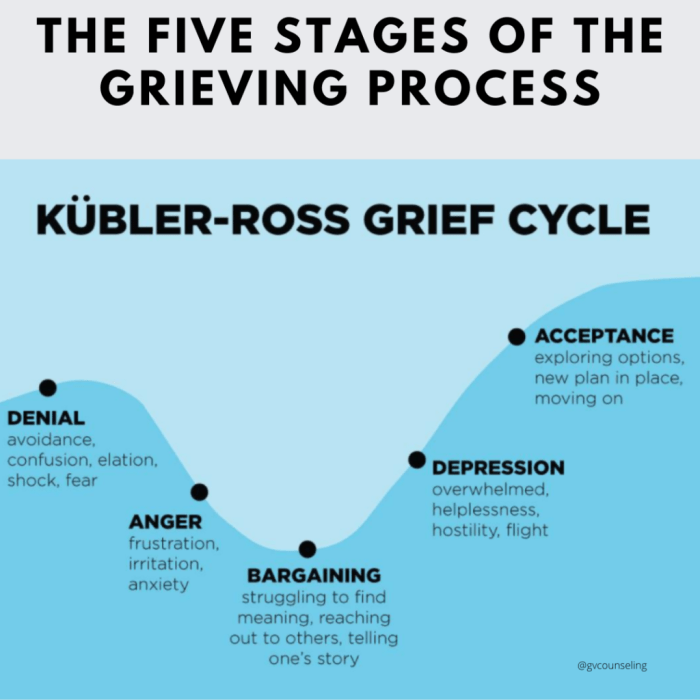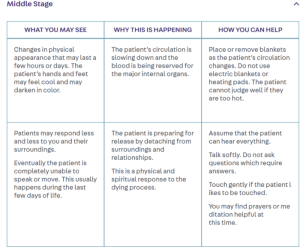
Death and grieving process is a universal human experience, yet each journey through loss is profoundly unique. This exploration delves into the multifaceted nature of grief, examining its various stages, coping mechanisms, and the impact on relationships. We’ll navigate the practical considerations surrounding death and dying, while also addressing the specific challenges faced by children and adolescents, and the complexities of complicated grief.
From understanding the Kübler-Ross model to exploring diverse coping strategies and support systems, this guide offers a compassionate and informative overview. We’ll examine the emotional, physical, and behavioral manifestations of grief, highlighting the importance of self-care and effective communication during this difficult time. Ultimately, our aim is to provide a resource that offers both understanding and practical guidance for navigating the complexities of loss and healing.
Coping Mechanisms and Support Systems: Death And Grieving Process

Grief is a deeply personal experience, and there’s no single “right” way to cope. Understanding and utilizing effective coping strategies and support systems is crucial for navigating this challenging period. The process is often complex, involving emotional, physical, and social adjustments, and seeking help is a sign of strength, not weakness.
Effective Coping Strategies for Managing Grief
Managing grief effectively involves a multifaceted approach. Strategies such as journaling, mindfulness practices, and seeking professional help can significantly aid in processing emotions and adapting to the loss. Journaling provides a safe space to express feelings without judgment, allowing for reflection and emotional processing. Mindfulness techniques, like meditation or deep breathing exercises, can help manage overwhelming emotions and promote a sense of calm.
Professional help, in the form of therapy or counseling, offers structured support and guidance in navigating the complexities of grief. These interventions can help individuals develop healthy coping mechanisms and address any underlying mental health concerns that may arise.
Roles of Various Support Systems in the Grieving Process
Support systems play a vital role in mitigating the intensity of grief and fostering healing. Family members often provide a sense of familiarity and unconditional love, offering practical assistance and emotional comfort. Friends can offer companionship, shared memories, and a sense of normalcy during a difficult time. Support groups, composed of individuals sharing similar experiences, provide a safe space for emotional expression, validation, and mutual support.
The shared experience fosters a sense of understanding and reduces feelings of isolation often associated with grief. Each support system offers unique benefits, contributing to a more holistic approach to healing.
The Importance of Self-Care During Grief, Death and grieving process
Self-care is paramount during the grieving process. It’s not selfish; it’s essential for maintaining physical and mental well-being. This encompasses various aspects, including prioritizing adequate sleep, maintaining a balanced diet, engaging in gentle physical activity, and avoiding excessive substance use. Self-care also involves setting healthy boundaries, allowing oneself time to grieve without feeling pressured to “move on” prematurely.
Engaging in activities that bring comfort and joy, even in small ways, can help restore a sense of normalcy and hope. Prioritizing self-care ensures the individual has the strength and resilience to navigate the grieving process effectively.
Effectiveness of Different Types of Therapy for Grief
Several therapeutic approaches effectively address grief. Cognitive Behavioral Therapy (CBT) helps identify and modify negative thought patterns and behaviors that may exacerbate grief. Grief counseling provides a dedicated space to process emotions, explore coping strategies, and address any unresolved issues related to the loss. Other therapies, such as psychodynamic therapy or art therapy, can offer alternative avenues for emotional expression and healing, depending on individual needs and preferences.
The effectiveness of therapy often depends on the individual’s engagement, the therapist’s expertise, and the therapeutic approach’s suitability for their specific circumstances.
Pamphlet Outlining Resources and Support Available to Those Grieving
A pamphlet could include information on local grief support groups, helplines (e.g., national suicide prevention lifelines), online resources offering grief support and information (websites and apps), and contact information for therapists specializing in grief counseling. It could also list self-help books and websites dedicated to grief management, and emphasize the importance of seeking professional help when needed. The pamphlet’s design should be simple, easy to read, and visually appealing, using calming colors and clear, concise language to avoid overwhelming the reader.
It should provide a sense of hope and emphasize that healing from grief is a process, not a destination. The pamphlet could also include testimonials from individuals who have successfully navigated grief, offering a message of hope and resilience.
Grief and Relationships

Grief profoundly alters our relationships, impacting how we connect with others and how others connect with us. The intensity and nature of this impact vary significantly depending on the type of relationship and the individual’s coping mechanisms. Understanding these dynamics is crucial for navigating the grieving process effectively and maintaining supportive relationships.Grief’s Impact on Different Relationship Types
Grief’s Effects on Romantic Relationships
The death of a partner irrevocably changes a romantic relationship. Surviving partners often experience profound loneliness, alongside the practical challenges of managing life alone. The grieving process can lead to intense emotional volatility, potentially straining the already fragile emotional landscape. Conversely, shared grief can also strengthen the bond between partners, creating a deeper understanding and appreciation for each other’s resilience.
For instance, couples who successfully navigate the loss of a child often report a strengthened bond, forged in the shared experience of immense pain. However, if the couple lacks effective communication or support systems, grief can lead to misunderstandings, resentment, and ultimately, the dissolution of the relationship.
Grief’s Effects on Familial Relationships
Family relationships are often tested by grief. The loss of a parent, sibling, or child can create significant rifts, particularly if unresolved family conflicts pre-existed the loss. Differing grieving styles and coping mechanisms can lead to friction, with some family members seeking emotional support while others withdraw. However, shared mourning can also bring families closer together, fostering a sense of unity and mutual support.
For example, a family who unites to plan a meaningful memorial service may find themselves strengthening their bonds through shared purpose and remembrance. Conversely, the absence of shared grief rituals or open communication can exacerbate existing tensions and create further distance.
Grief’s Effects on Platonic Relationships
Grief can also impact friendships. The loss of a close friend can be incredibly isolating, leaving the survivor feeling alone in their pain. Friends may struggle to offer appropriate support, unsure of what to say or do. This can strain the friendship, leading to feelings of abandonment or inadequacy. However, a strong friendship can withstand the challenges of grief, with supportive friends providing a much-needed sense of companionship and understanding.
A supportive friend might offer practical assistance, like helping with errands or simply listening without judgment. Conversely, the lack of support from friends during this period can create feelings of isolation and resentment.
Challenges of Supporting Someone Who is Grieving
Supporting someone who is grieving presents unique challenges. It requires patience, empathy, and a willingness to adapt to the grieving person’s needs. Individuals grieve differently, and what works for one person may not work for another. The lack of appropriate support can exacerbate the grief experience, potentially leading to prolonged suffering or even complications such as depression.
For instance, well-meaning friends offering unsolicited advice or minimizing the individual’s pain can be counterproductive.
Importance of Communication and Empathy in Navigating Grief Within Relationships
Open and honest communication is paramount in navigating grief within relationships. Creating a safe space for expressing emotions, without judgment or pressure, is crucial. Empathy, the ability to understand and share the feelings of another, is essential for providing effective support. It is important to acknowledge the individual’s pain and validate their feelings, rather than attempting to fix or minimize their grief.
Active listening and showing genuine concern are crucial for fostering a sense of connection and support.
Effective Communication Strategies for Interacting with Someone Experiencing Grief
Effective communication is key to navigating grief within relationships. Here are some strategies:
- Listen actively and attentively, without interrupting or offering unsolicited advice.
- Validate their feelings and acknowledge their pain, avoiding minimizing statements like “at least…”
- Offer practical support, such as helping with chores or errands.
- Check in regularly, but respect their need for space.
- Be patient and understanding, recognizing that grief is a process, not an event.
- Avoid pressuring them to “get over it” or “move on.”
- Simply be present and offer your support, even if you don’t know what to say.
Death and Dying
Facing the death of a loved one is an incredibly difficult experience, both emotionally and practically. Beyond the grief and emotional turmoil, there are numerous legal and logistical tasks that need to be addressed. Understanding these practical considerations can help alleviate some of the burden during an already challenging time. This section Artikels the key steps involved in navigating the end-of-life process and the aftermath.
End-of-Life Care Planning
Planning for end-of-life care allows individuals to express their wishes regarding medical treatment, pain management, and the location of their final care. Advance directives, such as living wills and durable powers of attorney for healthcare, are crucial legal documents that Artikel these preferences. These documents ensure that individuals retain control over their medical care even if they are unable to communicate their wishes directly.
Discussions with family members and healthcare professionals are essential to ensure these wishes are clearly understood and implemented. Options for end-of-life care include hospice care, which focuses on comfort and pain management, and palliative care, which aims to improve the quality of life for individuals with serious illnesses. Choosing the appropriate care setting, whether at home, in a hospice facility, or in a hospital, should be based on individual needs and preferences.
Funeral Arrangements
Funeral arrangements involve making decisions regarding the type of service, burial or cremation, location, and other details. These decisions often involve significant emotional and financial considerations. Families should discuss their loved one’s wishes, if known, and consider the cultural and religious traditions that are important to them. Pre-planning funeral arrangements can alleviate some of the stress during a time of grief.
This includes selecting a funeral home, choosing a casket or urn, and deciding on the details of the service, such as readings, music, and eulogies. Understanding the costs associated with funeral arrangements is also crucial for effective financial planning.
Administrative Tasks Following a Death
Navigating the administrative tasks after a death can be overwhelming. A step-by-step approach can help manage this process effectively. The first step typically involves obtaining a death certificate from the attending physician or hospital. This certificate is then used to notify relevant institutions such as banks, insurance companies, and government agencies. Other essential tasks include closing bank accounts, managing credit cards, and dealing with wills and estates.
Contacting an attorney specializing in probate law can provide invaluable support during this complex legal process. Notifying employers and social security is also a crucial step in securing benefits and resolving any outstanding financial obligations.
Emotional and Logistical Challenges for Families
The dying process presents significant emotional and logistical challenges for families. The emotional toll includes grief, stress, and anxiety related to the loss of a loved one. Logistical challenges include managing medical care, coordinating funeral arrangements, and handling administrative tasks. The support of family, friends, and professional counselors can be invaluable during this period. Open communication within the family is essential to address the diverse emotional needs and responsibilities that arise during this time.
The financial burden associated with medical expenses, funeral costs, and estate settlement can also be a significant source of stress.
Resources for Managing the Practical Aspects of Death and Dying
The process of dealing with death and dying can be significantly simplified with the help of various resources.
- Funeral Homes: Provide guidance on funeral arrangements, including costs and legal requirements.
- Attorneys specializing in probate and estate law: Assist with legal matters related to wills, trusts, and estate settlement.
- Hospice and Palliative Care Organizations: Offer support and resources for end-of-life care.
- Grief Counseling Services: Provide emotional support and guidance for coping with grief and loss.
- Social Security Administration: Provides information on death benefits and survivor benefits.
- Government Websites: Offer information on legal requirements and administrative procedures related to death.
Grief and Children/Adolescents
Grief manifests differently in children and adolescents compared to adults, largely due to their developmental stage and limited life experience. Understanding these unique challenges is crucial for providing effective support and fostering healthy coping mechanisms. Their expressions of grief might be less verbal and more behavioral, requiring careful observation and sensitive interpretation from caregivers and support professionals.
Supporting grieving children and adolescents involves a multifaceted approach that considers their age, developmental level, and personality. It necessitates patience, empathy, and a willingness to adapt strategies based on their individual needs and responses. Creating a safe space for them to express their feelings, without judgment or pressure, is paramount to their healing process. Open communication, consistent routines, and access to appropriate professional support are key components of effective intervention.
Explaining Death to Children
Age-appropriate explanations of death are crucial for children’s understanding and acceptance of loss. For younger children (preschool age), explanations should be simple, concrete, and focus on the cessation of life functions. Metaphors like “sleeping” can be helpful, but should be clarified to avoid confusion later. For older children and adolescents, more complex explanations incorporating the permanence of death and the grieving process are appropriate.
Honest and open communication, tailored to their comprehension level, is essential. It’s important to answer their questions directly and honestly, avoiding euphemisms or overly simplistic responses that may not address their concerns.
Comparing and Contrasting the Grieving Process in Children and Adults
While both children and adults experience grief, the expression and processing of it differ significantly. Adults typically exhibit more verbal expression of their emotions, whereas children may express their grief through changes in behavior, such as regression, clinginess, or acting out. Adults often have a more developed understanding of death’s permanence and the grieving process, allowing for more complex emotional processing.
Children, however, may struggle with the concept of permanence, leading to fluctuating emotional responses and difficulty understanding the finality of loss. Adults usually have a broader support network and coping mechanisms, while children rely heavily on their caregivers for emotional regulation and support.
Creating a Safe and Supportive Environment for Grieving Children
Creating a safe and supportive environment is crucial for helping children and adolescents navigate their grief. This involves providing a consistent and predictable routine, allowing for ample time for emotional expression, and minimizing significant life changes during the grieving period. Open communication is vital; caregivers should encourage children to express their feelings without judgment and provide reassurance that it’s okay to feel sad, angry, or confused.
It’s important to validate their feelings and help them understand that their grief is normal and understandable. Involving children in age-appropriate memorial activities, such as creating a memory book or planting a tree, can provide a healthy outlet for their emotions and foster a sense of connection with the deceased. Access to professional support, such as grief counseling or support groups, can be beneficial for both the child and their family.
Navigating the death and grieving process is a deeply personal journey, demanding resilience, support, and self-compassion. While the stages and experiences may vary, understanding the emotional, practical, and relational aspects of grief empowers individuals to seek appropriate support and foster healing. Remember that seeking professional help is a sign of strength, not weakness, and that healing takes time. By embracing empathy, communication, and self-care, we can navigate loss with greater understanding and find pathways towards healing and renewed hope.
General Inquiries
What is the difference between grief and mourning?
Grief is the internal emotional response to loss, while mourning is the outward expression of that grief, often influenced by cultural norms and personal beliefs.
Is it normal to feel angry after a loss?
Yes, anger is a common emotion in the grieving process. It’s a natural response to the pain and disruption caused by loss.
How long does the grieving process typically last?
There’s no set timeframe. Grief is highly individual and can last for months or even years. It’s important to be patient with yourself.
When should I seek professional help for grief?
If your grief is significantly impacting your daily life, relationships, or mental health, or if you’re experiencing prolonged or debilitating symptoms, seeking professional help is recommended.






